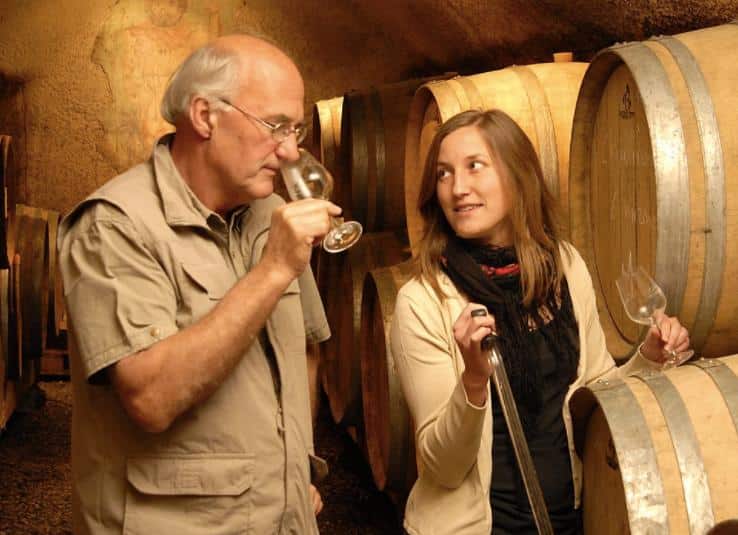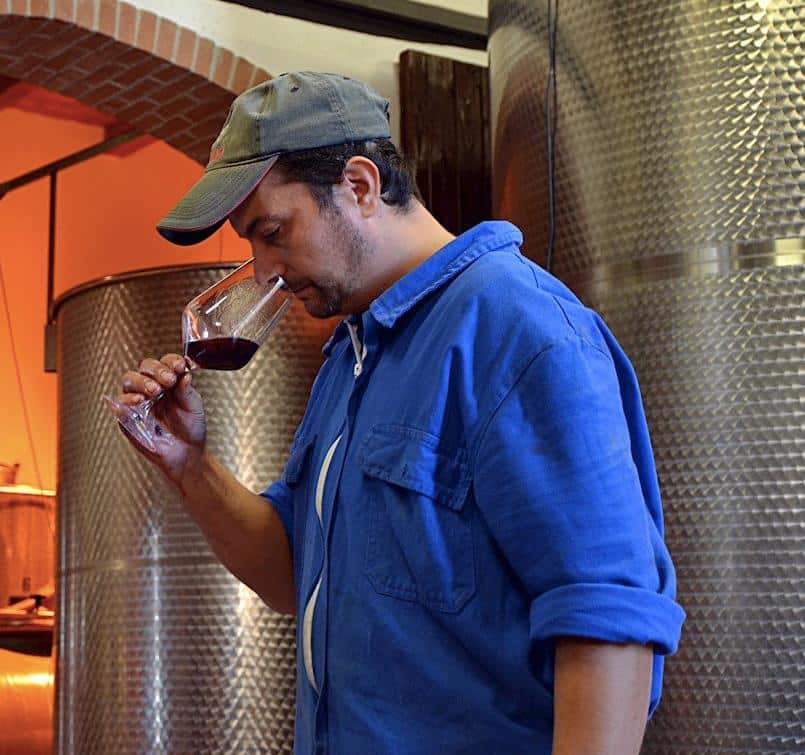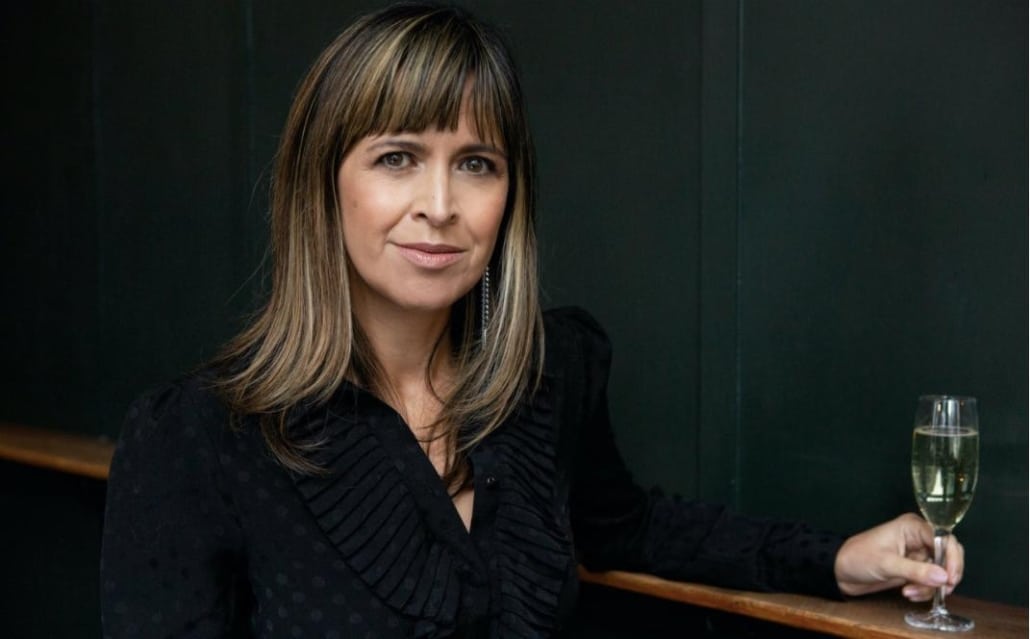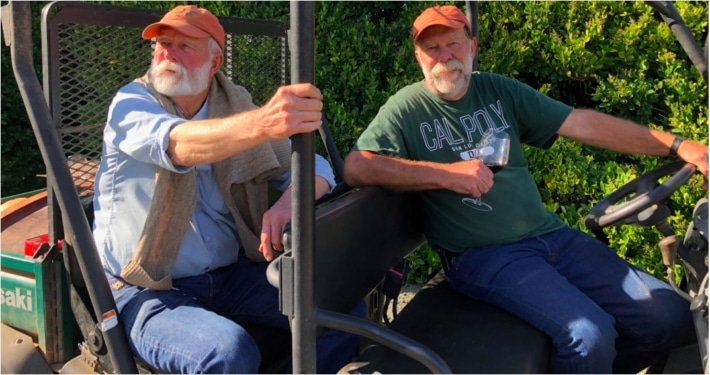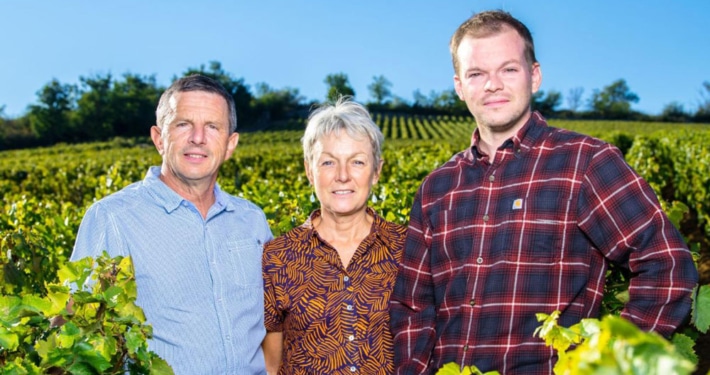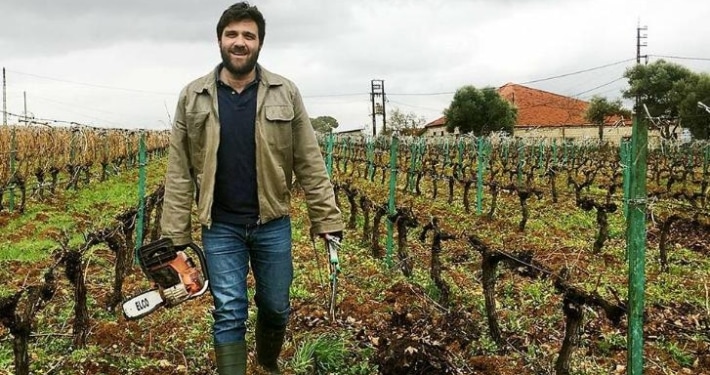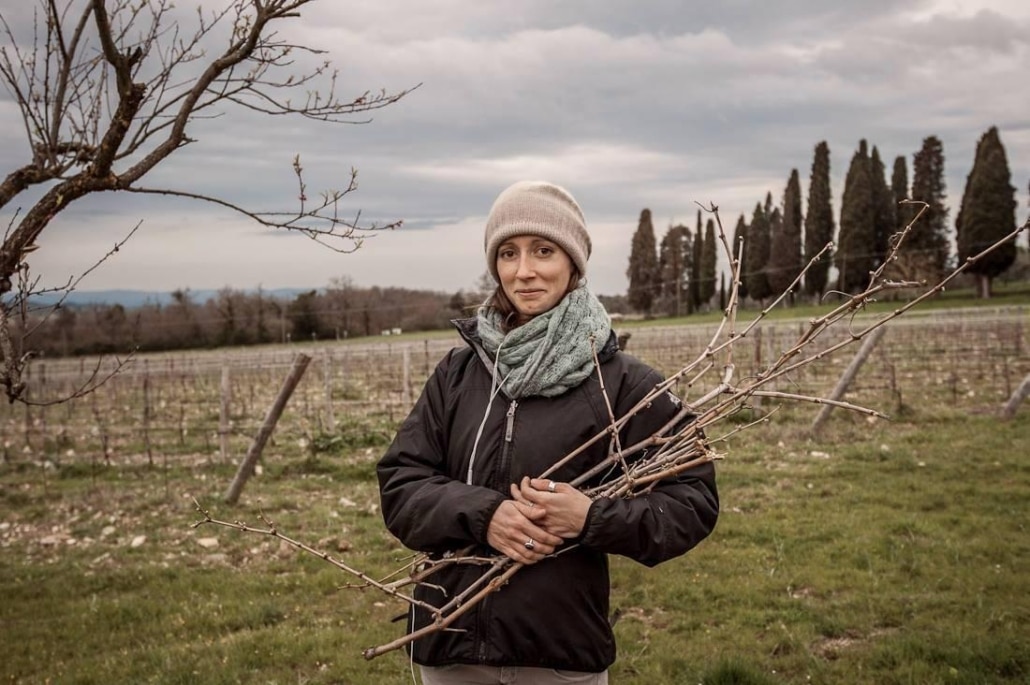DOUGLAS BARDEN MARGERUM
Doug’s philosophy is to return to winemaking’s previous form of production – handcrafted and personal.
Doug Margerum has been intimately involved in the Santa Barbara food and wine scene for over 40 years and is widely regarded as one of the pioneers promoting the uniqueness and quality of the region’s food and wine. His food and wine explorations started at an early age while traveling with his parents in France. In 1981, Doug and his family founded the Wine Cask in Santa Barbara, which was a legendary restaurant known for its wine program and in 1994 became one of the 74 restaurants in the world to earn the coveted Wine Spectator Grand Award. Doug launched the Wine Cask Futures program in 1990 and owned and founded Vita Nova Winery with Bob Lindquist (Qupé) and Jim Clendenen (Au Bon Climat) in 1986. Doug sold the Wine Cask in 2007 after deciding to devote all of his energies to winemaking having started Margerum Wine Company in 2001.
Doug’s philosophy is to return to winemaking’s previous form of production – handcrafted and personal. Margerum produces limited quantities of wines made from grapes grown at the Estate Vineyard in the Los Olivos District and at top vineyards from around Santa Barbara County. The wines are made at their state-of-the-art winery located in Buellton. Margerum produces M5 wines (Rhône-style varietal white and red blends), a co-fermented Syrah called Über, Sybarite Sauvignon Blanc, Riviera Rosé and other single varietals Rhône wines. The Margerum Estate Vineyard was established in 2016 with 10 Rhône varietals planted on 18 acres. In 2014, Doug released the Barden wines, which focuses exclusively on the terroir of the Sta. Rita Hills, sourcing fruit from top vineyards in the appellation and makes limited amounts of world-class, cuisine-friendly and age-worthy wines.
Doug has long been a fabric of the Santa Barbara community and through his long friendship with Julia Child, he sits on the Smithsonian’s National Museum of American History Kitchen Cabinet, a board made up of leaders in the food and wine industry. Doug is also on the advisory board for the Julia Child Foundation and is currently the Treasurer for the Santa Barbara County Vintner’s Foundation, the charitable arm of Santa Barbara Wine Country. Doug also consults and produces wines for several local wineries including Happy Canyon Vineyards and Paradise Springs Winery. Additionally, he created several popular negociant and private label programs for restaurants and retail all over the country including the labels for Riviera Wine Company, Valle de Inez and Diseño Wine Company.
Doug was recently nominated as Winemaker of the Year for the 23rd Anniversary of the Wine Enthusiast’s coveted Annual Wine Star Awards, which honors individuals and companies that make outstanding contributions to the wine world.
The Weis wines can be summed up in one word: precision.
PETER AND ASHLEE WEIS
Hans Peter (Peter) Weis is the seventh generation in his family to make wine; however, he’s the first generation to make wine outside of the Mosel. Born and raised in Zell, Germany, Peter first came to the US for a winemaking job in Sonoma. A friend who was working at Dr. Konstantin Frank’s winery encouraged Peter to stop in the Finger Lakes on his way home…he never left. “The climate was nice and cold,” he says. For the next 10 years, Peter managed Dr. Frank’s German varietals from vineyard to glass, which helped him forge connections with terrific growers all over the Finger Lakes.
It is there that he met his wife Ashlee, born and raised in Hammondsport, Finger Lakes. Ashlee grew up enjoying the beautiful area surrounding Keuka Lake and could not help but return after receiving her degree in business administration and marketing. She began working within the wine industry shortly after. In 2016, they received the opportunity to buy a property on the East side of Keuka Lake from retiring winemakers. They took a leap of faith and produced their first vintage that year. The tasting room was opened in May 2017 and in the Spring of 2020, they started their first estate vineyard, Day Road. Located by Keuka Lake just minutes from the winery, it is planted with Riesling, Chardonnay, Cabernet Franc and Saperavi, a teinturier-type grape variety native to the country of Georgia.
The Weis wines can be summed up in one word: precision. Every one of Peter’s wines has a pure and elegant focus, the result of a detailed, Germanic-style dialogue between a winemaker and excellent vineyard sites. In a very short period of time, Weis Vineyards has emerged as one of the most exciting wineries in the Finger Lakes.
MAROUSSIA TATIN, Domaines Tatin (Tremblay)
Maroussia, the youngest daughter of Chantal Wilk and Jean Tatin, was born in 1985 in Paris. She obtained her degree in Viticulture Oenology in 2006 in Tours and continued her studies by attending the PURPAN agricultural engineering school in Toulouse. During that time, she traveled to Canada, California, Spain and Argentina.
In September 2010, she returned to work on all sides of the family estate, from communication and marketing to the vinification of the wines.
Her passion for flavors and cooking was passed on to her by her grandmother Jacqueline. The passion for wine came later, but the two seem inseparable. She says that she “loves to play dinette” in her cellar in Le Tremblay where, together with Jean, they have fun trying out different vinifications and creating micro-cuvées.
Together they decided to plant Pinot gris and Pinot blanc to make Mam’Zelles Bulles: a natural sparkling wine that will be the perfect companion to the famous Tarte Tatin. And yes, the Tatin sisters are part of the family’s ancestry!
Started by Jean Tatin and Chantal Wilk more than 20 years ago, Domaines Tatin spread over 35 hectares. The cuvées of Quincy are sold under Domaine du Tremblay and Domaine des Ballandors, and the cuvées of Reuilly under “Les Demoiselles Tatin” (4 hectares total, mostly Pinot Noir with the parcel “La Commanderie” and the rest for Sauvignon Blanc and some Pinot Gris).
Started by Jean Tatin and Chantal Wilk more than 20 years ago, Domaines Tatin spread over 35 hectares.
Silvio’s philosophy is: “Better work makes better wines, not machines.”
SILVIO BUSCA, Poderi Roset
Silvio Busca, now in his late forties and the owner of Poderi Roset, was the original winemaker when the estate was created in 1993 by Alessandro Brero. Silvio comes from a family that grows hazelnut trees (Piedmont is famous for hazelnuts) and he still has 20 hectares under production. He went to wine school in Alba and started making wine at Brero. Energetic and open to new ideas, he is part of a tasting group of winemakers who like to share their experience and tips. Silvio is married to Stefania, Alessandro Brero’s daughter. In 2007, he and a partner, Alberto, bought the winery from Alessandro.
Silvio’s philosophy is: “Better work makes better wines, not machines.” He dislikes sitting at a desk and enjoys spending time in his vineyards; some of which he owns, others he rents, all cultivated with the same care. He never uses tractors for they would erode the soil. He brings cows to the vineyards, every 3 years to plow the soil, and has not used chemicals since 2006.
The domaine now comprises 15 hectares of vineyards, including one hectare of the rare Pelaverga di Verduno (only 8000 cases are produced in the entire DO, with a total of 21 hectares planted) and 3.5 ha in Barolo. Silvio leases a small portion (0.5ha of the 15ha) of the Monvigliero (“mountain view”) vineyard, 500 meters above sea level. Only eight other producers work this vineyard. Since 2009, Silvio also makes a cuvée from the Cannubi vineyard, where he leases 0.5ha. The grapes for his Dolcetto and Pelaverga come from lower elevation vineyards with a northwest exposure; conditions not favorable to Nebbiolo, but that bring into balance these high sugar varieties. His total production is around 75,000 bottles.
AMANDA THOMSON, Noughty
Amanda Thomson is the CEO and Founder of Thomson & Scott. After a successful career as an Arts Broadcaster at the BBC, she moved to Paris and studied for her Diploma in Wine at the renowned Le Cordon Bleu School. She noticed that people were becoming increasingly concerned about what was in their food, but no one was asking what was in their wine. Having been brought up on a vegetarian, no sugar diet by her health conscious single mother, she had a keen interest herself in healthy living. Her idea of creating a Champagne brand based upon honesty and transparency won Amanda the school’s coveted Entrepreneur Award. This led her to work with top wineries to craft her own line and create an entirely new sector in the wine industry: sparkling wines that cut unnecessary sugar, are organic & vegan certified, and above all clear about what’s in the bottle.
However when she looked into alcohol free wines, the offerings were depressingly bad; they didn’t consider the wine part seriously. Amanda thought she could take a sophisticated, vinous approach to crafting an alcohol-free sparkling just as she created their alcoholic counterparts. Time and research led her to southern Germany and Carl Jung, whose family has a patented method of de-alcoholization, dating from 1908. A partnership fermented, and Noughty, a perfectly balanced alcohol-free Blanc de Blancs was born.
Her idea of creating a Champagne brand based upon honesty and transparency won Amanda the school’s coveted Entrepreneur Award.
STU AND CHARLES SMITH (Smith-Madrone, Napa)
Stu and Charles Smith are proud pioneers of mountain-top winemaking in the Napa Valley. The brothers purchased 200 acres of land atop Spring Mountain in 1971, defying the contemporary norm in the region of making wine only on the valley floor. The family-run Smith-Madrone Winery is dedicated to producing fine wines exclusively from its own land. Charles tends to the wine while Stu minds the vineyards. Stu notes “I don’t wear contacts and he does. He can’t be out in the dust. I can sit on the tractor all day.”
The winery’s name has two sources: it is as a tribute both to the Smiths who pursued their dream and to the Madrone trees distinguishing the property. “It sounds better than Smith-Douglas Fir, Smith-Manzanita, Smith-Oak and certainly Smith-Poison Oak. The Madrone was a predominant tree on the property when we began,” Stu explains. “We had so much physically and emotionally invested in the development of the vineyard and the winery that we selfishly wanted our name on it. Smith is not exactly a grand Mediterranean wine name, and certainly we couldn’t call it just “Smith Winery.” He shares that the Madrone’s personality figures into this as well: “It never stands out, alone, in the forest; it’s always clustered for shade and protection with others.”
“We value the elegance, finesse and restraint of Europe, which with a little California sunshine gives a very distinctive wine.”
The winery was hand-built, using stones and lumber from the property. A cellar and the main floor house French and American barrels. The building’s roof – boasting stunning 360-degree views of the floor of the Napa Valley and the Sierra Nevada Mountains in the distance – is used for entertaining. Another striking historical and visual note is the dramatic corridor of twenty two 120-year-old Picholine olive trees, which descend below the winery’s slope into the vineyards. The trees which were carefully preserved when the vineyards were re-planted. Their huge proportions – some stretch as tall as 35 feet – are a testament to their struggle for precious mountain sunlight.
Stu specifically selected slopes with different exposures per varietal: eastern exposure for Riesling, southern and western exposures across flat stretches for Cabernet Sauvignon; the coolest north-facing slopes for Chardonnay. The history of international viticulture supported his early belief in the potential of these mountain grapes, which would have to “struggle” to produce. Drip irrigation was used to establish the vineyard but today it is mostly dry-farmed.
The vines send their roots deep to search for water and nutrients, only producing the precise amount of fruit exactly appropriate for their vigor, small berries with a large skin-to- juice ratio. “They should have lots of layers of interesting flavors,” Stu said. Charles and Stu don’t mind if the wines comes off leaner or lighter than what is typical for California wines. “Their acidity must be snappy. We value the elegance, finesse and restraint of Europe, which with a little California sunshine gives a very distinctive wine.”
GILLES MORAT
Gilles Morat was born into a wine family in the now-chic village of Vergisson in the heart of the Mâconnais, where his father and grandfather owned vines but had always sold their grapes to negociants. In 1997, after 15 years of working in the electronics industry and spending one year in wine school in Davayé, Gilles decided it was time to move back to his home town so that his children would enjoy the same life he did growing up.
Gilles thrives on maintaining an artisanal approach. The six-hectare property resides on Vergisson’s steep, east-facing amphitheater slopes— the very heart of the appellation where yields are kept low, elevating its terroir to find full expression in his Pouilly-Fuissé cuvées.
The domaine’s small size allows Gilles to effectively micro-manage his vineyards: he avoids vine problems with precise pruning to keep yields low, constantly checking his vines during growing season and using minimal organic copper-sulfite treatments only when needed. When necessary, he hand-plows the rows with different tools according to the season, and manually removes the grass directly under the vines. Harvesting is also done by hand at optimal maturity, with careful selection in the vineyard. His barrel program is also quite specific: after some experimentation and careful research, Gilles found a secret source for creating customized fine-textured barrels from the Allier and Cher forests in France’s center, enhancing the style of wine he seeks. The soil and site specific cuvées of Bélemnites and Sur La Roche were launched in 2001. From the outset, Gilles’ vision was to bottle the majority of his production and make wine in the elegant, pure style that has become his hallmark.
Gilles Morat, his wife Joelle and their son Pierre
“If Pouilly-Fuissé can be said to have superstars, then Gilles Morat would certainly count as one.”
— The Wall Street Journal.
FAOUZI ISSA (Domaine des Tourelles, Bekaa Valley)
Faouzi Issa is the youngest, most dynamic winemaker in Lebanon today. After receiving a Masters degree in Oenology at the University of Montpellier, he apprenticed under René Rostaing in Côte Rôtie followed by working a vintage at Châteaux Margaux. After his father wisely urged him to ‘get back to Bekaa Valley’, he took the reins of Domaine des Tourelles in 2008 at the age of 26. His indefatigable energy and efforts have paid off: his family’s wines are amongst the most recognized and awarded in Lebanon.
When speaking with Faouzi, his passions are clear. His first is Bekaa Valley, which—he is quick to point out—is more ‘old world’ than most with its 2000 year-old history. Situated on a plateau sandwiched between two mountain chains (~3,300 feet in elevation), Bekaa Valley’s terroir has all the conditions in place for organic farming: climate, diurnal range of temperatures, low humidity, soil diversity and just the right amount of rainfall. Situated in the highest sub-region of Chtaura, Domaine des Tourelles consists of 100 acres of vineyards, all organic and dry-farmed. Faouzi stresses the uniqueness of the region: “Lebanon is not Burgundy, Lebanon is not Bordeaux, Lebanon is a wine-producing country with a long history. So if I want to be scientific, I would say the Bekaa Valley is one of best areas in the world. If I want to be poetic, I would say it’s the sexiest area in the world.”
Which leads us to his second passion: Cinsault. “If you Google ‘100% Cinsault’, you will find Domaine des Tourelles popping up because we created a revolution by making 100% Cinsault in Lebanon–even Jancis Robinson picked 2014 Vieilles Vignes as the wine of the week on her website in 2017. We take our Vieilles Vignes and participate in lots of wine competitions either in Lebanon or internationally. In these competitions, we were against Cinsault from all over the world, like South Africa, Chile, Argentina and the South of France. Our Cinsault was one of the best among all of the competitors. How our wine differentiates from the others is the altitude and the terroir of Bekaa Valley.”
“Minimal intervention in the vineyard is what we do. Because the minimum amount of spray you use on the vines, the better their immunity will be.
But the other key ingredient, of course, is the Faouzi’s winemaking—his third passion. Decanter dubbed Faouzi Issa the ‘dusty winemaker’ due to the fact he believes the cellar dust provides a unique, ambient diet for the yeasts, which in turn creates distinct character in the wines. He uses only concrete vats (rare in Lebanese wineries) which he believes provide the best biological conditions for a natural winemaking process and helps preserves the authenticity of his wines.
“Minimal intervention in the vineyard is what we do. Because the minimum amount of spray you use on the vines, the better their immunity will be. The fewer chemical products you use, the better the wine will taste, with vital aromas. And if you create, or you raise, a good indigenous yeast, with time, you will have a consistent quality of wine. So my philosophy is minimal intervention. Let’s put it this way, if you work in Bordeaux, it’s all about the weather. It is always foggy and humid, sometimes we need to treat in order to prevent fungus to grow. But in Lebanon, the philosophy is go wild, get a wild product, and that’s it.”
*Interview excerpts sourced from Grape Collective article: “Faouzi Issa of Domaine des Tourelles: Making the Adopted Grape Cinsault Shine in Bekaa Valley.”
MARTIN REYES (Peter Paul, Sonoma)
Prior to becoming winemaker and chief wine officer at Peter Paul Wines, Martin Reyes, MW, had already experienced a staggering level of success in the wine world. As a former Senior Buyer and Importer for The New York Times Wine Club, Williams-Sonoma Wine, The Washington Post Wine Club and Global Wine Cellars, as well as consultant to the Michael Mina Wine Club, he knows the ins and outs of fine wine, from crush to consumer. Martin has traveled extensively throughout wine regions, both classic and off the beaten path, experiences he found invaluable.
His winemaking strategies include site specific-winemaking and negociant-style blending, which to him means “more mud on the boots and miles on the odometer, but also the freedom to sleuth vineyards, sample barrels and shake a few hands.” His hope is to continue the tradition at Peter Paul Wines to craft wines of substance and longevity. Like his predecessors, Martin works especially close with two farming families – the Bacigalupis, with their historic Russian River Chardonnay vineyard, and the Karrens, from the rising powerhouse Terra de Promissio Pinot Noir vineyard in Petaluma.
Above all, Martin aims to express all that the Sonoma coast has to offer. Whether single vineyard or an appellation blend, his wines showcase the sunny, easygoing temperament of fruit grown here without losing the more refined elements of the grape’s DNA and European heritage. “Each wine offers the proper balance of fruit, savor, and structure to hit a ‘sweet spot’ of ripeness without confection, and fullness with manners.”
In addition to wine, he is making history. In the spring of 2018, Martin received the title – Master of Wine (MW) and is one of only 47 MWs in the USA, and the first of Mexican descent in the world. Martin is also an instructor for the Wine & Spirits Education Trust, and a Certified Wine Educator. In addition, Martin was recognized in the Wine Enthusiast’s “Top 40 under 40 Tastemakers in the USA,” in October 2015, is on the advisory board for a luxury winery estate in St. Helena, and serves as an expert panelist for the Wine Program at his alma mater, Stanford University. In his free time, he is working to become fluent in a fifth language, and together with his wife, raises his two children trilingually in Vallejo, CA.
Sourced from Peter Paul Wines, peterpaulwines.com
“Being where the grapes were grown and working directly with those sources, I was able to delve into understanding how a fruit or wine from a particular terroir or vintage will ultimately reveal itself in the glass.”
“As a winemaker I love to be prolific with the amount of varieties grown. They are all my babies, they all find homes … so why not?”
KAREEM MASSOUD (Paumanok, North Fork)
Assuming the reins in 2001, Kareem Massoud is second-generation winemaker at Paumanok Vineyards, located on the North Fork of Long Island. Established in 1983 by his parents Charles (from Lebanon) and Ursula (from the Pfalz in Germany) at a time when Long Island winemaking was in its infancy, the family has always adhered to an ‘old world’ philosophy of expressing terroir and origin of place.
Paumanok has been a pioneer on many levels:
- First (and for a long time only) producer of Chenin Blanc, which is now considered to be their flagship wine;
- Embraced screw-caps early on;
- Experimenting with ungrafted vines; and
- In partnership with Cornell University, innovated an aggressive canopy management system that cuts down the pyrazine levels, which are responsible for green notes such as grass or bell pepper in the final wines.
Kareem is meticulous in the cellar (he laughs, “after all, I am half German!) and tends to keep a very light hand in terms of oak and use of sulfites. Aside from the Festival White and Red, all Paumanok wines are made entirely from estate fruit, sustainably grown. “As a winemaker I love to be prolific with the amount of varieties grown. They are all my babies, they all find homes … so why not?”
In fact, Paumanok is the only NY winery growing three Loire varieties: Sauvignon Blanc, Chenin Blanc and Cabernet Franc, and in addition, they also grow Riesling, Merlot, Cabernet Sauvignon and Petit Verdot.
The winery has been recognized with numerous accolades over the years including wine service at The White House, Wine Spectator’s Critic’s Choice Award, NY Wine & Food Classic’s “Winery of the Year” Award and “outstanding” reviews in Robert Parker’s Wine Advocate and a nomination for Wine Enthusiast’s “American Winery of the Year”.
DIANA LENZI (Fattoria di Petroio, Tuscany)
Fattoria di Petroio is led by Diana Lenzi, the daughter of estate founders Pamela and Gian Luigi Lenzi. Following her mother’s “learn as you go” motto, Diana throws herself into running the business with great passion and energy; she follows and directs all phases of production commercially and promotionally, both in the vineyards and the cellars. As a member of Women in Wine and Young Agricultural Entrepreneurs (ANGA), she works diligently to bring Petroio to even higher levels of excellence while respecting its history and traditions.
After graduating with a political science degree from the University of Rome, Diana trained as a chef in several Michelin-starred restaurants, returning to Tuscany in 2008. “The winery was part of my life. I knew I’d end up here one day. Also, my dad couldn’t keep taking care of it; his real career is as a neurologist, and he’s quite famous. It was impossible to do both.”
“I cook and produce wine in exactly the same way. I start with the ingredient, which has to be the absolute best I can find. If I do a tomato sauce from my own garden, with nothing else but olive oil and basil I’ve grown, I’ll knock people out of their chairs. If I use a so-so industrial tomato, I can do the most intricate, complicated tomato-gelatin dish there is, and they’ll forget it before they’re even done eating. Wine is the same. I have beautiful, healthy grapes here —those are my ingredients. And I know my wine works when it reminds the person who takes a sip specifically of the grape from that vintage.”
As a pioneer within Italy’s male-oriented society — where women have had to fight for recognition by doing outstanding work — she shared, “Here in Tuscany, an estate would be passed onto a daughter only if there was no other choice. That’s changing. Plus, more women are pursuing professions in viticulture and enology. At Petroio, my right-and left-arm is Ilaria Marcomini, who’s worked here since 2001. She picked the books I studied and taught me chemistry. Out in the vineyards, she’d show me what a specific sort of discoloration on a grape leaf might mean.”
Diana is also among a handful of producers indirectly tasked with rebranding Chianti Classico, which somewhat butchered its reputation during the 1980s-90s. Notes Diana about that era, “You never knew what you were going to get in the glass–the wine could be modern or classic, round or tannic, diluted or powerful, you name it. The identity was gone. Now the best estates have gone back to what the land wants them to do. It’s an incredible return to our origins and a very exciting time for Chianti.”
I start with the ingredient, which has to be the absolute best I can find.
MICKAEL AND JEAN-PAUL PICARD (Loire Valley)
Jean-Paul Picard et Fils is a family owned and operated winery, renowned for sensational Sancerres since 1750. Nearly three centuries later, descendent Mickaël assumed the helm in 2004 as lead winemaker. He pays particular attention to the development of his wines, guaranteeing the expression of terroir and his two grape varieties, Sauvignon Blanc and Pinot Noir. This allows a range of wines for all tastes: fruity whites and rosés as well as structured reds.
The best villages have developed their own reputation for quality, with Bué considered among its finest.
Fusing sustainable modern farming applications with traditional craftsmanship, Mickaël insists on harvesting his grapes manually — unlike 90% of Sancerre’s producers who harvest mechanically. He blends his fine Sancerre Blanc from the select Grand Chemarin and Chêne Marchand vineyards. Superb terroir and limited production translate into lusciously generous, gratifying wines.
The peculiarity of his estate is 45 small parcels of vines each with their own characteristics, proving that not all Sancerres are created equal; as Sancerre is a large appellation, the best villages have developed their own reputation for quality, with Bué considered among its finest.
The vineyard slopes surrounding this charming hamlet boast outstanding clay-limestone soils, sunny southwestern exposures and ideal elevations. Half the area is grassed over, especially on steep slopes to limit soil erosion. Mickaël works the soil by decomposing the vines and superficial plowing, further enriching the terrain’s microbial life, using indigenous yeasts to respect these differences resulting in wines of great complexity.



